
The Newbie Gains Guide for Skinny Guys
If you’re new to lifting weights, you can build muscle incredibly fast. Lifters call this phenomenon “newbie gains.” Most men can gain over 20 pounds of muscle during their first year alone. Skinny guys can often do even better.
We specialize in helping skinny guys build muscle, and we’ve worked with over 10,000 clients over the past decade. We do this all day, every day, with clients ranging from everyday desk workers to professional and Olympic athletes. There are methods to get incredibly consistent newbie gains. But there’s a catch.
Although most new lifters build muscle quickly, some “hardgainers” fail to gain any muscle whatsoever. What’s going on here? Why are some guys able to build a lifetime of muscle in a single year, whereas others spend an entire lifetime unable to build a single year’s worth of muscle?
In this article, we’ll explain what newbie gains are, how they cause such rapid rates of muscle growth, how to take advantage of the phenomenon, and how to avoid becoming a “hardgainer.”
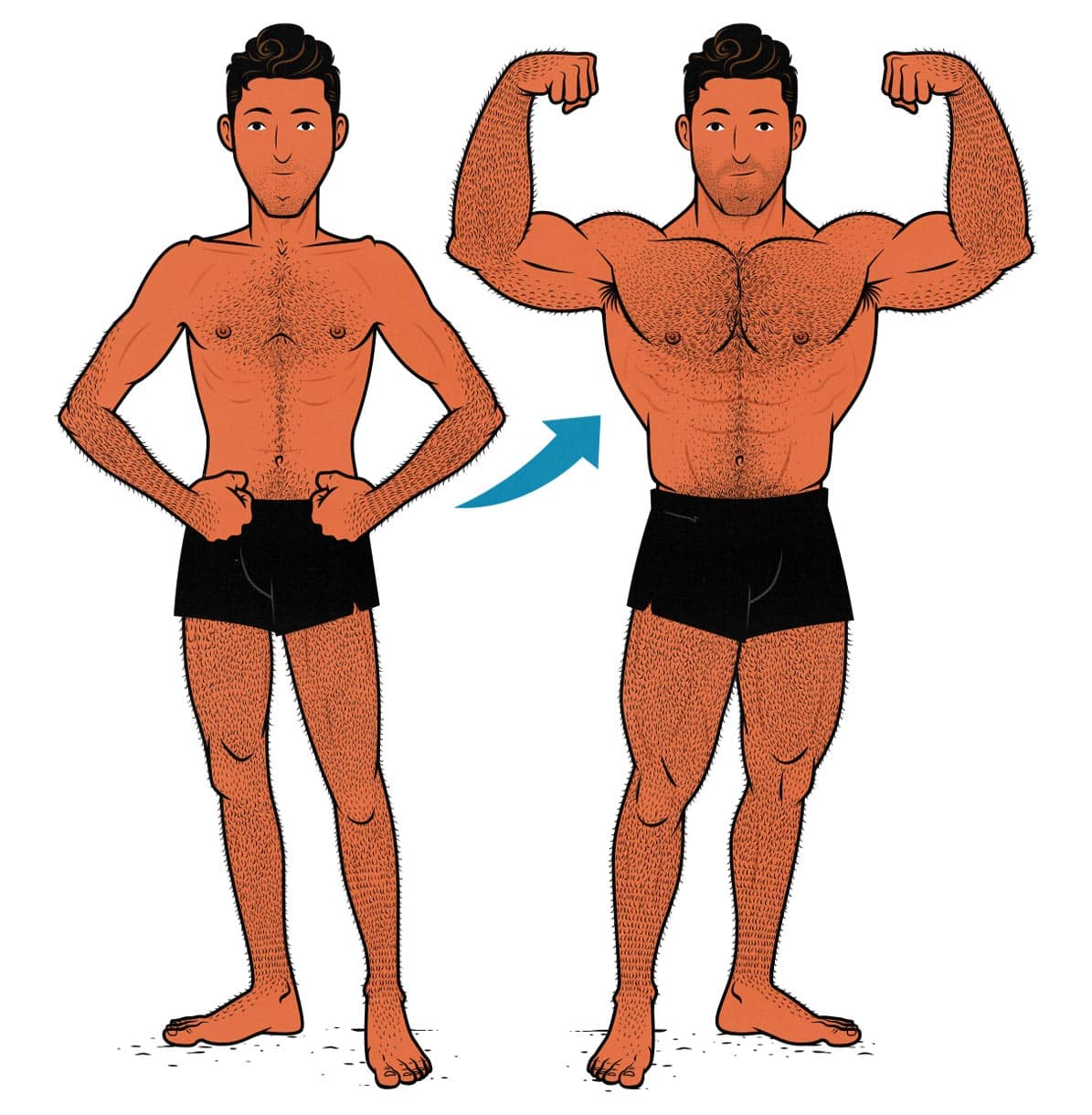
What Are Newbie Gains?
Newbie gains, sometimes called noob gains or noobie gains, is the period of rapid muscle growth people experience when they first start training and eating for muscle growth.
When you first start training for muscle growth, your muscles get sore and inflamed, you start storing more energy in them (as glycogen), and you quickly build new muscle tissue.
When you start eating for muscle growth, you fill your stomach with food, your muscles inflate with even more glycogen, and your body starts investing the extra energy (calories) you’re eating into muscle growth (by converting protein into muscle tissue). If you’re supplementing with creatine, it may draw even more fluid into your muscles (article here).
As you practice lifting weights, your coordination will improve, allowing you to lift heavier weights more easily. Some of these coordination improvements are from conscious practice and technique improvements. Some run deeper. Your brain will learn how to better communicate with your muscles, allowing them to cooperate more gracefully and contract more forcefully.
It’s common to gain a few pounds of relatively lean mass during your first 2–3 weeks of bulking. All the food, fluid, swelling, and muscle growth add up quickly. You’ll add weight and reps to all your lifts, too. That isn’t the end of your newbie gains. It’s only the beginning.
How Fast Can Beginners Build Muscle?
During my first five weeks of bulking, I gained twelve pounds. My roommate gained 22. We didn’t gain a noticeable amount of fat. But then, after posting our results online, we discovered our results were considered scientifically impossible (by people who weren’t scientists).
The skeptics were wrong, but they had a point. The conventional wisdom is that the average beginner can gain around 20 pounds of muscle in his first year of weight training. If we look at the research, that doesn’t seem to be true:
- In this study, beginners gained 9 pounds of muscle during their first 8 weeks of working out.
- In this study, beginners gained 12 pounds of muscle during their first 10 weeks of weight training.
- In this study, beginners gained 15 pounds of muscle during their first 12 weeks of lifting weights.
These studies show beginners gaining more than a pound of lean mass per week for several months in a row. This proves it’s possible to gain muscle quickly and that a good bulking program can reliably produce these rates of muscle growth. If you want an idea of what that looks like in real life, here are the average results our members get. Here’s an example:
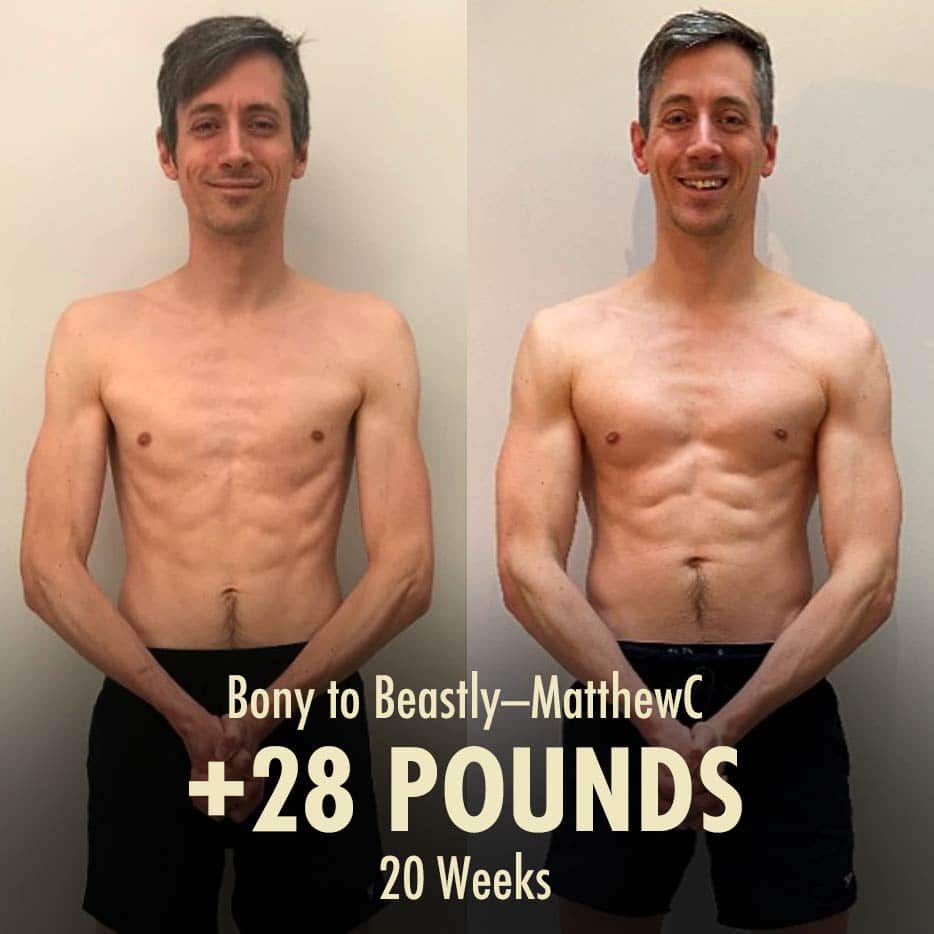
The next thing to consider is how these rates of muscle growth vary between people. In this study, they found that:
- The average beginner added 2 inches to their biceps in 12 weeks.
- Some beginners added 5 inches to their biceps in 12 weeks.
- Other guys lost muscle, even though they were following the same workout routine.
This study shows that some beginners can gain muscle much faster than others. That’s not the concerning part, though. The study also highlights the phenomenon of “hardgainers.” Some beginners struggle to build any muscle when they first start lifting weights.
get the google spreadsheet of the
free beginner’s full-body workout
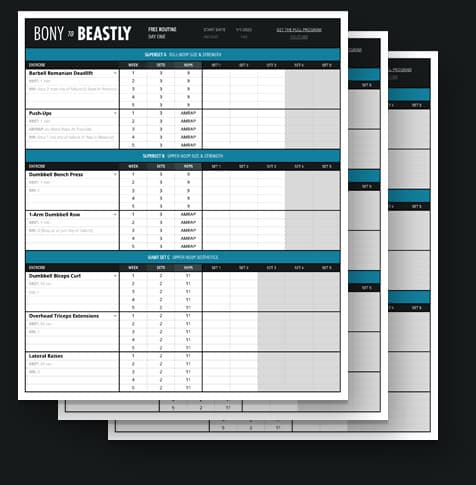
Get the workout as a Google spreadsheet. You’ll be able to pick from exercise alternatives, fill out the sheet, and get our beginner’s warm-up.
Plus, we’ll make sure you’re on the b2B newsletter, and send you all of our best muscle-building content.
The Hardgainer Problem
If you’re like me, you might assume “hardgainers” have poor muscle-building genetics. I failed to gain any muscle during my first few bulking attempts. When I searched for what was going wrong, I found a mix of “just eat more” and “you’re doomed.” I was already trying to eat more, so I feared I was doomed.
Fortunately, though oversimplistic, the “just eat more” advice was closer to the truth. It didn’t help me eat more. It took me a long time to figure out how to eat enough calories to gain weight. But once I did, I was able to build muscle astonishingly fast.
- Skinny guys can often build muscle faster than the average person. Our bones can only support a certain amount of muscle, and as we get closer to that limit, our rate of muscle growth slows. The less muscle we have on our bones, the more quickly we can fill our frames out. Because we’re starting out less muscular, we can build muscle faster.
- Hardgainer don’t always have bad muscle-building genetics. The rate we build muscle is limited by the rate we gain weight. After all, if we aren’t eating enough calories to gain weight, how can we expect to gain muscle? This is especially true for skinny guys. The only way to go from 130 to 150 pounds is to gain weight.
- Skinny guys are rarely low-responders. The correct term for someone with below-average muscle-building genetics is a “low-responder.” This refers to their lower response to resistance training. The stress of lifting weights doesn’t provoke as powerful of an adaptive response. This has nothing to do with being skinny. Most skinny guys have perfectly good muscle-building genetics. And besides, even low-responders can build muscle. It’s just slower, harder, and requires a more deliberate approach.
- “Skinny-fat” guys are often out of shape. Being skinny-fat rarely means you have bad genetics, just that you aren’t exercising, eating, and living in a way that suits you. It’s fairly common for skinny guys to become skinny-fat as the years pass.
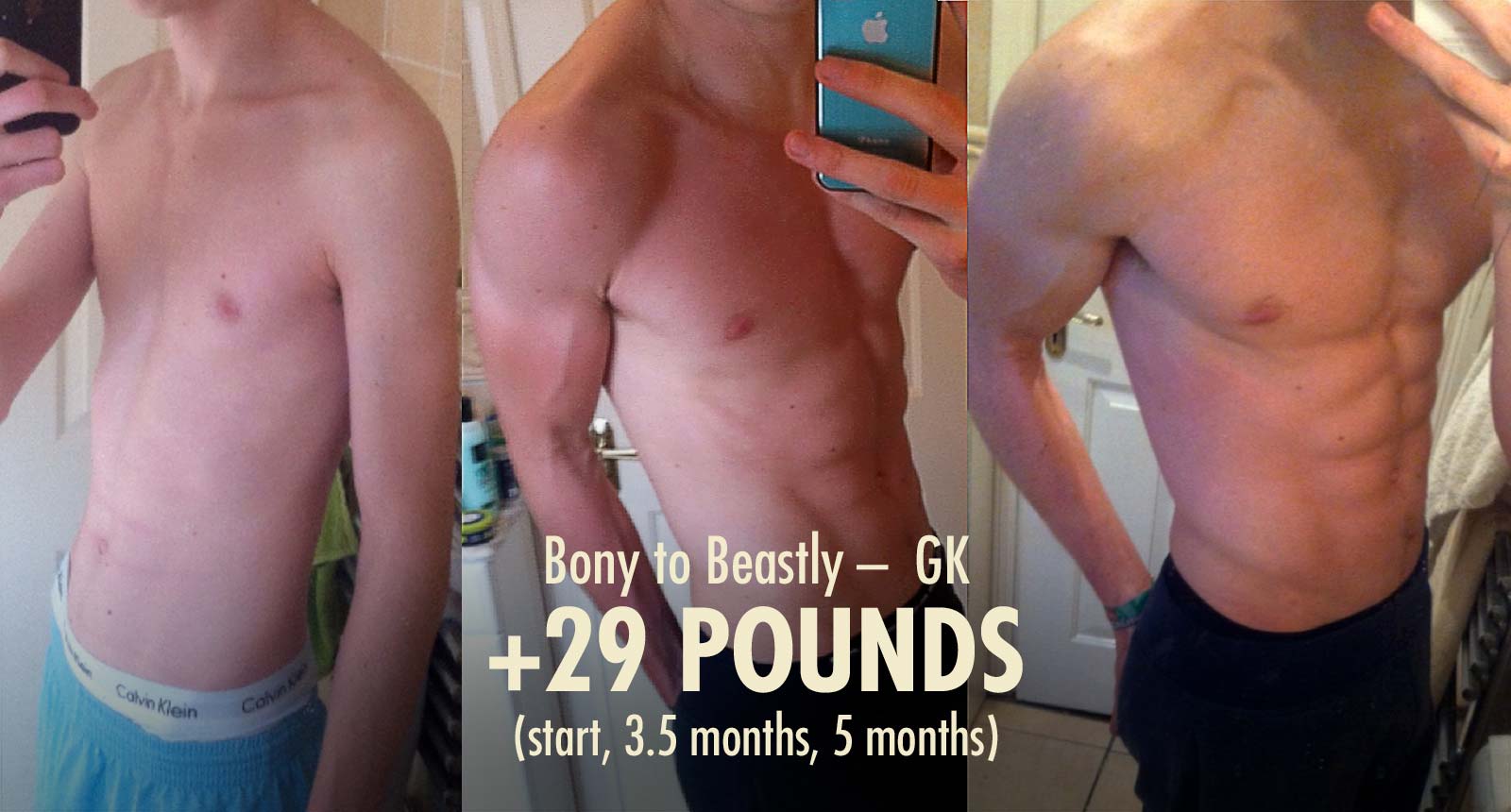
Skinny Beginners Build Muscle Faster
I’ve asked several hypertrophy researchers why skinny guys build muscle so quickly. They’d all noticed the phenomenon. They’d seen it in their study participants and training clients. Some of them have even experienced it themselves. But nobody knows for sure why it happens. The best we can do is make educated guesses.
My theory is that we’re starting off with more room for growth, allowing us to gain muscle more quickly, at least until we catch up to everyone else. It aligns with what we’ve personally experienced. It fits with what we’ve seen in the thousands of skinny clients we’ve worked with.
So, to understand our exaggerated newbie gains, we must compare our starting point against the average man’s. Most guys are starting off with roughly eighty pounds of muscle on their frames. If we imagine a skinny guy with forty pounds of muscle on his frame, he’s starting off behind the starting line:
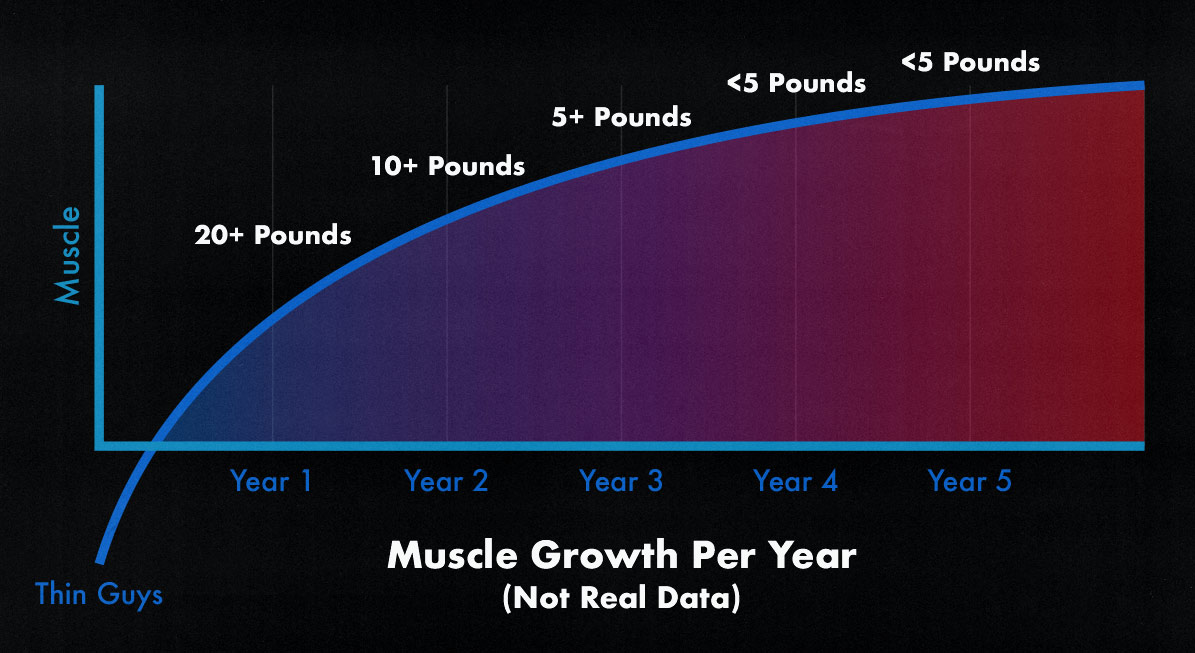
This matters because our potential rate of muscle growth slows as we inch closer to our genetic muscular potential. If all else is equal, it’s easier to gain your first pound than your second. Mind you, there’s a learning curve to building muscle. If you get better at bulking as you go, you may find it easier to build muscle as your methods and skills improve.

If you’re starting out skinny, follow a good bulking program (such as ours or another), and get help from a mentor or coach, you can probably gain twenty pounds of lean mass in less than a year. In our experience, most guys following our program can gain 20 pounds of relatively lean mass in 3–6 months. Some outliers can do it much faster. Others take a bit longer.
How Long Do Newbie Gains Last?
Newbie gains last until you’ve packed a comfortable amount of muscle onto your frame. Mind you, everyone’s frame can hold a different amount of muscle. Your newbie gains will run out when you’ve gained an amount of muscle that’s comfortable for your body.
If you’re starting off skinny, you can probably get newbie gains for several months. Maybe as long as a year. You’ll build muscle quickly until you’ve bulked your thinness away. Your newbie gains will gradually slow as you fill your frame out.
If you have a wide frame, thick bones, and good muscle-building genetics, you might be able to keep making newbie gains until you’re impressively muscular. Your frame can hold more muscle, so you can continue filling it out for longer.
Newbie Gains Gave Me 55 Pounds
I started bulking at 130 pounds, at 6’2, with a BMI of 16.7. I was clinically underweight. My doctor was urging me to bulk up for the health benefits. My roommate was in the same situation, but he had the added problem of various weakness-related issues, such as poor posture and tendon pain.
We exploded in size when we finally figured out how to combine hypertrophy training with an abundant bulking diet and a healthy lifestyle. Our bodies were desperate for extra muscle mass, especially since we were training so hard. Our newbie gains were remarkable because we had a dramatic amount of room on our frames.
David Epstein, the author of The Sports Gene, found that each pound of bone can support five pounds of muscle. I was very bony starting out. I had plenty of room on my frame. Bulking from 130 to 150 pounds was difficult, but the muscle growth came quickly and leanly.
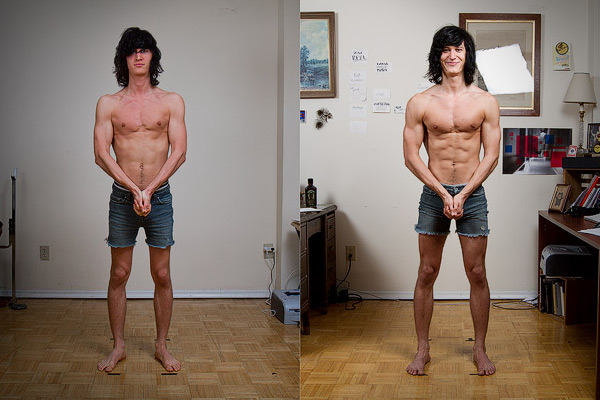
To my surprise, I got a second round of newbie gains. During my second 4-month bulk, I gained another 17 pounds, going from 150 pounds to 167 pounds. And once again, my gains were quite lean.
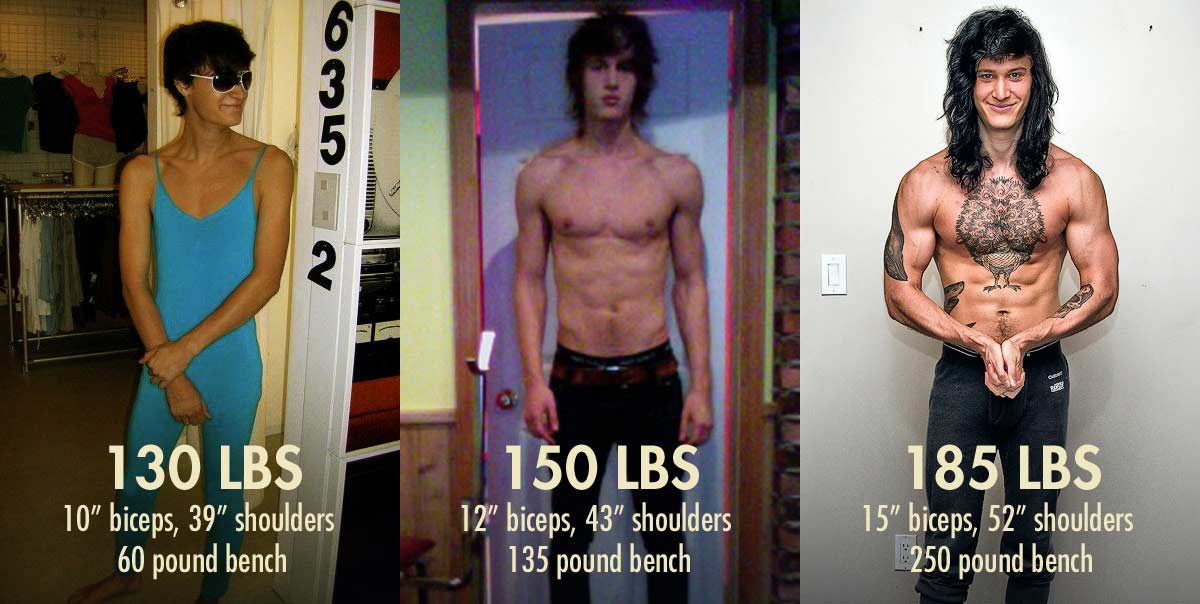
Then, I got newbie gains again. During my third bulk, I gained another 18 pounds, finally bringing me up to a healthy and athletic body weight:
An obvious objection is that not all lean mass is muscle. That’s true. Our stomachs stretch, our organs grow more robust, our bones get denser, we build new blood vessels, and we store more glycogen in our muscles.
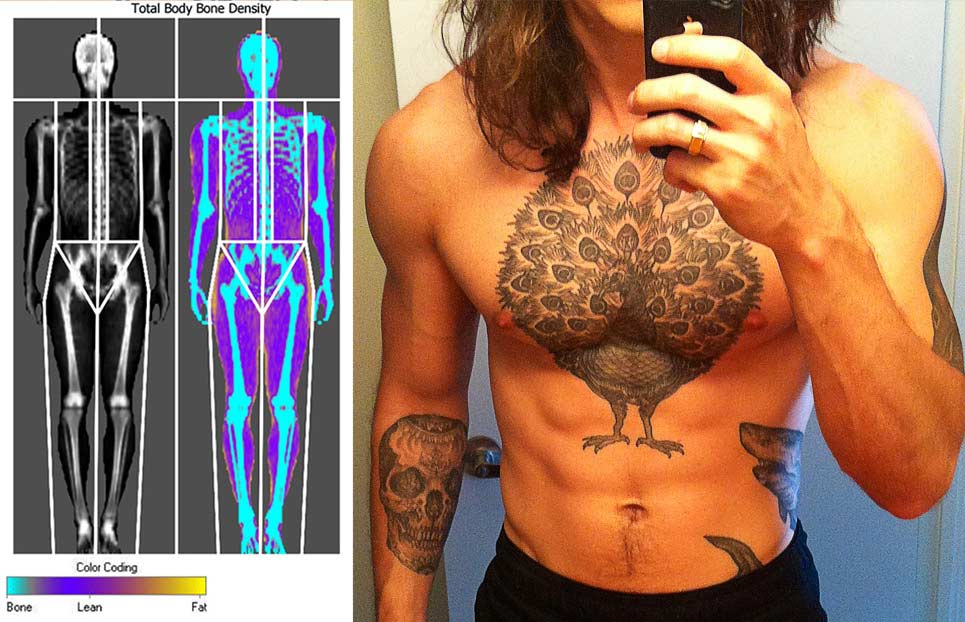
I got a DEXA scan showing a body-fat percentage of 11%. DEXA scans aren’t as accurate as most people assume. When measuring an individual, the margin of error is around 5% body fat in either direction (full article). That means I’m probably between 6–16% body fat here. 11% looks about right, though.
Anyway, the DEXA scan shows that I hadn’t gained much fat, but that doesn’t prove all my gains were muscle. Most of my gains were lean, but some of those increases in lean mass came from things like increased bone density (which had risen off the charts).
Can You Waste Your Newbie Gains?
People often ask us if they’ve wasted their newbie gains with their failed bulking attempts. Maybe they followed a bad workout program, ate a questionable bulking diet, or failed to eat enough calories to grow. They’re still skinny, and they fear they’ve trained away their newbie gains.
However, you can waste one aspect of your newbie gains. Sort of. There’s a phenomenon called the repeated bout effect (RBE). As you get used to the stress of lifting weights, your muscles grow tougher. They won’t get as sore or be as sensitive to the stimulus of lifting weights. But that’s not what newbie gains are. Not really. Newbie gains have more to do with how much more muscle your frame can hold.
Before I succeeded at gaining my first twenty pounds, I had already failed six bulking attempts. None of those failed bulks interfered with my newbie gains. If you haven’t succeeded at bulking up yet, you haven’t wasted your newbie gains.
If you’re still thin, you can still make newbie gains. If you’re still skinny, your newbie gains will be even more profound.
Why Do We Get Newbie Gains?
To get a deeper understanding of newbie gains, we need to look at what’s happening inside our muscle fibres. If you haven’t succeeded at building muscle yet, your muscle fibres probably have few myonuclei. Having even just a few myonuclei, though, is already quite remarkable. Most cells in our bodies have just one nucleus, putting a strict limit on how big they can get.

To understand how these myonuclei work, the researcher Greg Nuckols uses the analogy of a Wi-Fi router. The Wi-Fi router can project an internet signal a certain distance. Once you get too far from the signal, your device can no longer connect. Myonuclei function the same way. Each one can only handle an area so big. That area is their myonuclear domain.
Our muscle fibres can adapt to stress. If we challenge them enough, they will attempt to grow bigger. At first, the growth comes easily. Then it slows. Here’s why:
- In the short term, our muscle fibres fill their myonuclear domain. Think of it like more people coming into the café, connecting to the Wi-Fi routers that are already installed.
- When our myonuclear domains are full, we can’t build muscle until we gain more myonuclei. Think of it like the café running out of room, buying the building next door, and installing a new Wi-Fi router, freeing up a bunch of new space.
The Beginning of Newbie Gains: Claiming Your Domain
When you first start bulking, your muscle fibres will quickly expand to the limit of their nuclear domains. You can build muscle within your current Wi-Fi range without needing to make any structural changes. You can expect your muscle fibres to grow 15–27% before hitting that limit (study).
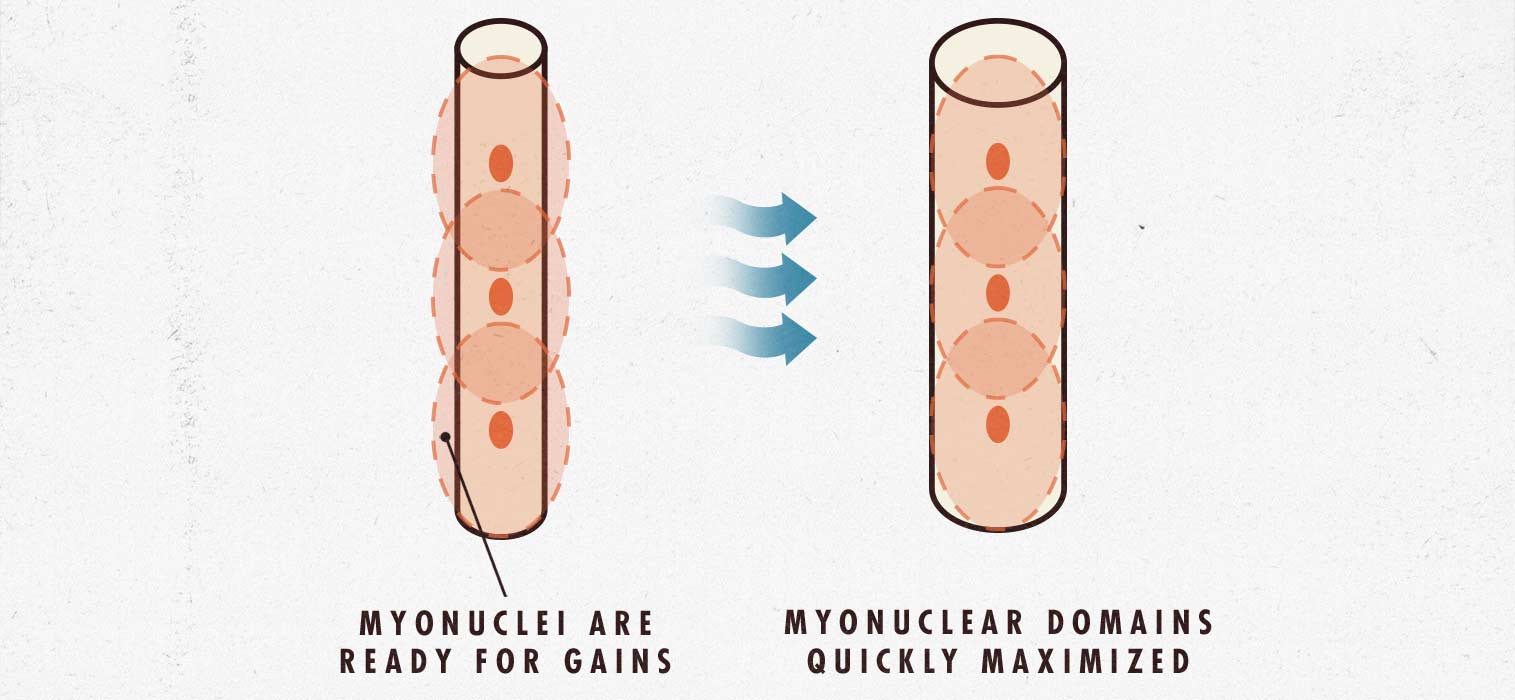
Since beginners aren’t near the end of their range, beginners can build muscle quickly. This early stage of newbie gains is so quick and explosive that it’s described as steroid-like growth.
This stage will last until you’ve maximized your nuclear domains. At that point, if your muscle fibres grew any bigger, your nuclei would lose control of them. So your body halts muscle growth until it can install new Wi-Fi routers—add new nuclei. As you can imagine, it’s common for people to hit a plateau at this point.
This first plateau can be confusing. The methods that helped you gain your first ten or twenty pounds might not be enough to stimulate further muscle growth. For example, if I want to use Wi-Fi from the balcony, I can sit right next to the door and get a signal. Working from there is no problem. But if I want to work from the far side of my balcony, there’s no signal there. I’d need to go to install a new router. It’s a hassle. Nothing has forced me to endure that effort, so I haven’t bothered.
Your body won’t go through the effort of adding new nuclei to your muscle fibres unless you give it a strong enough incentive. That’s why it becomes increasingly important to follow a good workout program, put your best effort into every rep, and eat a good bulking diet. If you can do that, your body will happily add new nuclei to your muscle fibres.
The End of Newbie Gains: Expanding Your Domain
Once you’ve reached the edge of your Wi-Fi range, the low-hanging fruits are gone. To continue growing, you must install new routers. If you’ve been doing a good job of bulking up, your body will have been doing this all along. You can begin adding new nuclei to your muscle fibres right from your very first workout (study).
Now that you’ve claimed your domain, from this point forward, every pound of muscle you gain will need to be preceded by gaining new nuclei. You add new nuclei to your muscle fibres by growing satellite cells and then fusing them into your muscle fibres, stealing their nuclei.
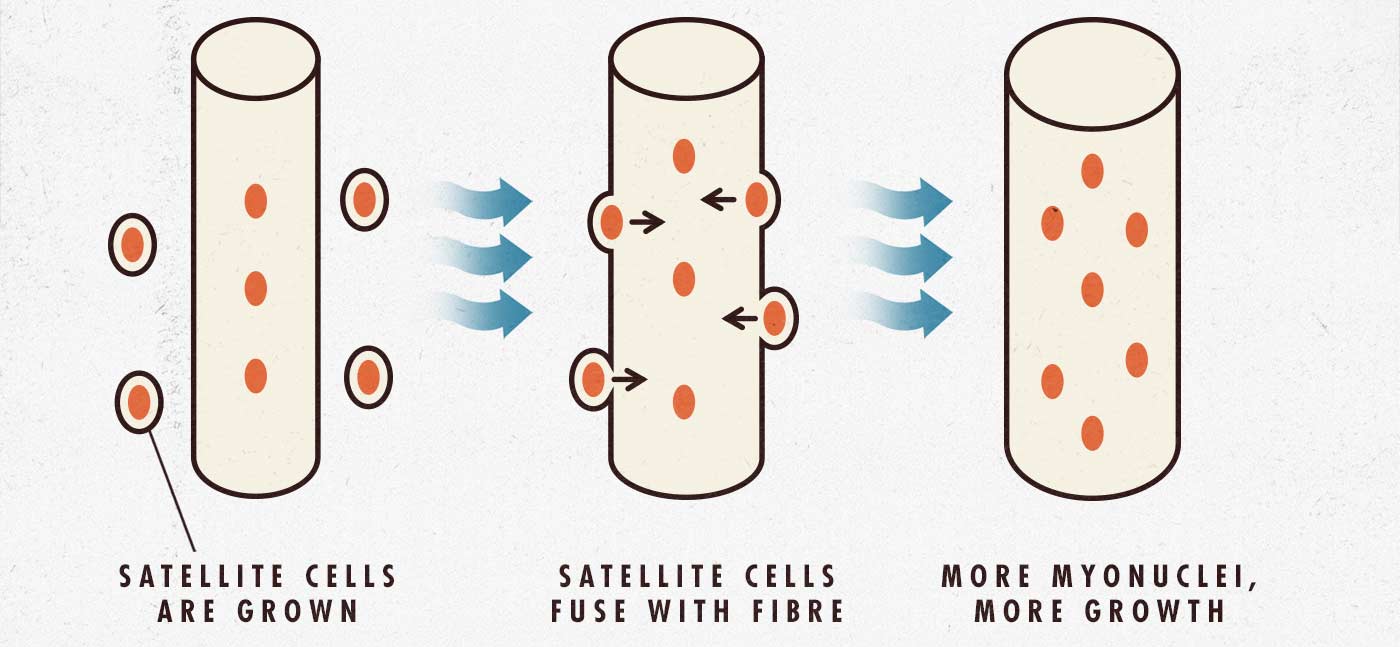
This allows for even more muscle growth, and this is where most of your overall muscle growth will come from. At first, this growth can be quite quick. This is the stage of newbie gains where guys gain another 10–20 pounds of muscle over another few months.
And this is where the magic happens. These changes are permanent. Once you go through the trouble of installing a new Wi-Fi router, it’s there to stay. Even if you stop lifting weights, you get to keep the extra myonuclei. This is why people can rebuild muscle so easily. They already have tons of mynuclei in their muscles.
Even as your rate of muscle growth slows, you can continue gaining more myonuclei for quite a long time. These new nuclei will allow you to grow much bigger (study). And that brings us to the final, mystical stage of muscle growth: building new muscle fibres.
What Happens After That?
You can continue adding nuclei to your muscle fibres for quite a long time, just with increasingly diminishing returns. As we alluded to earlier, it seems that these diminishing returns are due to our bones only being able to support a certain amount of muscle mass. Once you fill out your frame, your muscles will hesitate to add new nuclei.
By the time you get to the end of this road, your muscle fibres will be as thick as those of an athlete, strongman, or bodybuilder (study). You still won’t be quite as big as them, though, and the reason for that isn’t totally clear. They might have more muscle fibres, but it’s hard to say for sure.
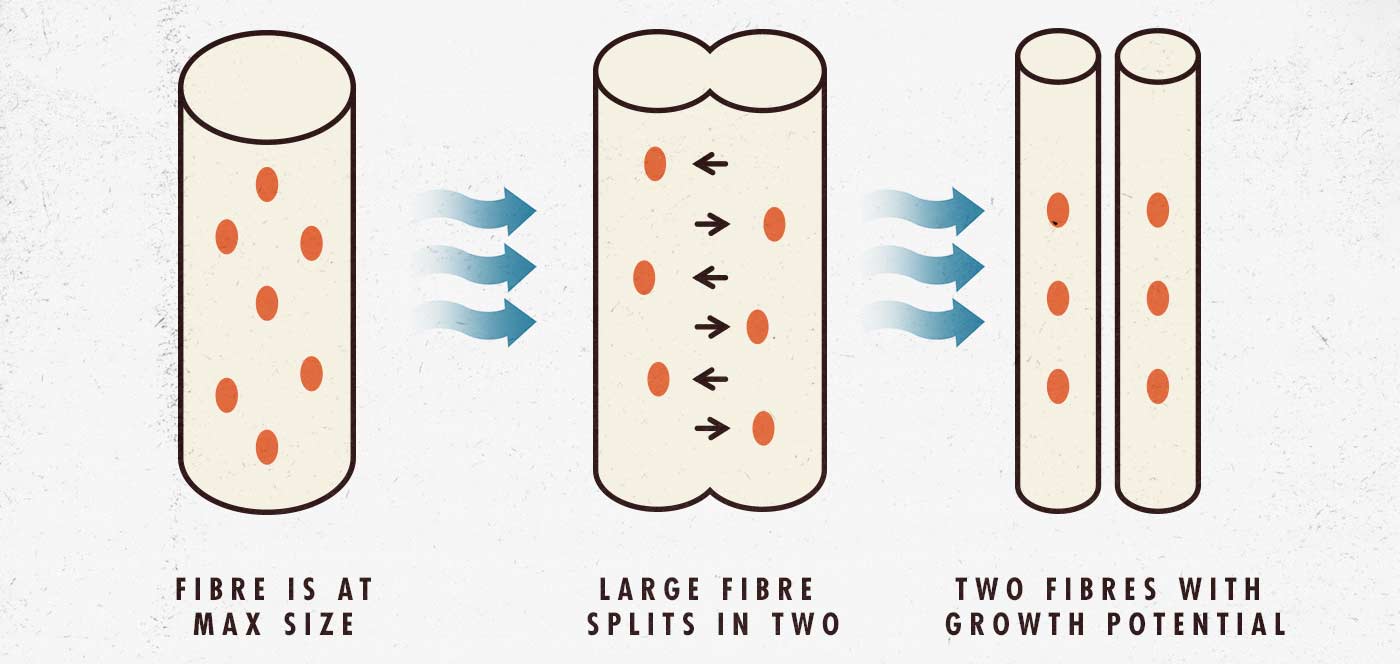
We’re at the advanced stage of muscle growth now, which is beyond the scope of this article. That’s a good thing, too, because this advanced muscle growth science is highly theoretical. We know that elite powerlifters have more muscle fibres than intermediate lifters, and we also know that animals can create new muscle fibres. With those two facts, we can infer that men can build new muscle fibres. But we don’t know for sure.
By this point, you’ll be muscular. You’ll have a strong physique that looks great. Continuing to make progress will be slower and harder, but you’ll already have a physique you can be proud of.
How to Get Your Newbie Gains
Now that you know what newbie gains are, how do you get them? Any type of resistance training can stimulate muscle growth. That includes bodyweight training, resistance bands, exercise machines, and, of course, free weights. Free weights are the most efficient, with exercise machines and calisthenics trailing closely behind.
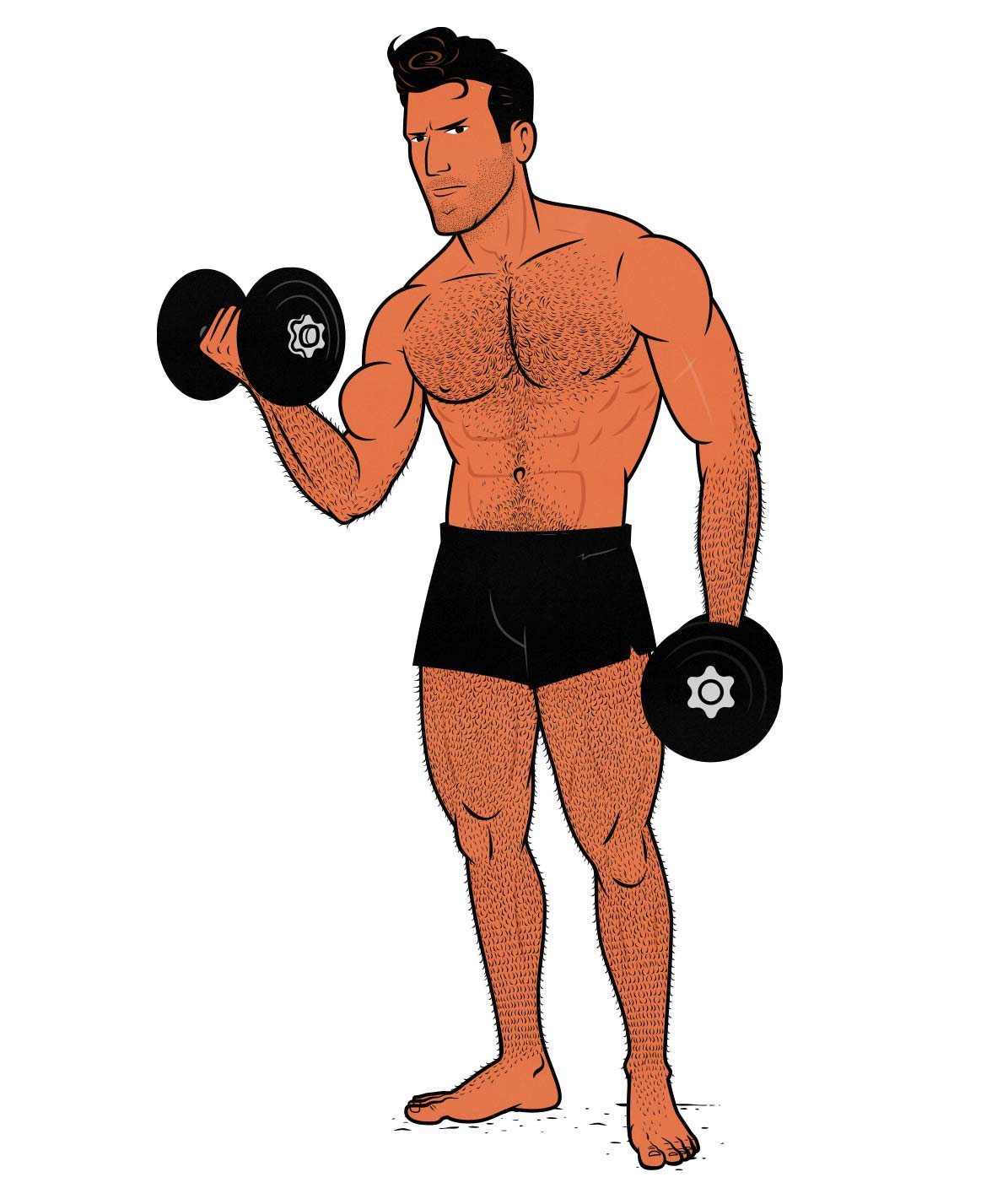
Whatever tools you use, you should do hypertrophy training. Hypertrophy training is designed to stimulate muscle growth. It’s the pursuit of size, but that size is functional, giving us a balance of muscle strength and endurance. It strengthens our muscle fibres (by adding contractile tissue) while increasing their work capacity (by adding sarcoplasm). We also develop denser bones, build new blood vessels, and improve our cardiovascular fitness.
Hypertrophy training will have you using moderately heavy weights, doing a moderate number of reps, getting a moderate amount of rest between sets, and doing a moderate number of sets and exercises.
Pair that training with a good bulking diet. Stimulating muscle growth motivates your body to build muscle. Once you’ve done that, you need to give your body the building materials (protein) and energy (calories) it needs to build that muscle. Eat a big, abundant, nutritious diet that has you gaining at least a little weight every week.
get our bulking recipes—smoothies, snack, & protein balls
4 free bulking recipes

Get four bulking recipes in a downloadable PDF file. Get the full explanation, ingredient list, macros, and steps to follow.
Plus, we’ll make sure you’re on the b2B newsletter, and send you all of our best muscle-building content.
To continue growing bigger and stronger, you need progressive overload. You must fight to lift heavier weights for more repetitions. You might need to start doing more sets. You may need to progress to more rigorous workout routines. The more muscle you build, the more challenging it gets to build more. Fortunately, you’ll have the size, strength, and vitality to handle the growing challenge.
Final Word
When we first start lifting weights, our muscles are sensitive to the stress of lifting weights. It doesn’t take much to provoke muscle growth or crippling soreness. As we adapt, our muscles grow bigger, stronger, and also tougher. This process of growing tougher is called the Repeated Bout Effect (RBE). It allows us to handle harder training but also makes it harder to stimulate growth. This is one reason why beginners can build muscle so quickly.
The main reason beginners gain muscle so fast is because of how far away from their genetic muscular potential they are. When our frames have plenty of room for muscle growth, our bodies build muscle extremely fast. This period of rapid growth is often referred to as newbie gains. And because our rate of muscle growth is determined by how much more muscle our frames can hold, skinnier guys can often build muscle faster than the average beginner.
However, to build muscle quickly, you need to follow a good hypertrophy training program, eat a good bulking diet, and live a healthy lifestyle that supports muscle growth. Most beginners, understandably, don’t know how to do that very well. Don’t worry, though. You won’t miss out on your newbie gains. You’ll get them as soon as you learn how to bulk properly.

If you want help bulking up, we can walk you through the entire process from start to finish. Our Bony to Beastly Program includes a 5-month workout routine, tutorials teaching every exercise, a diet guide, a recipe book, and a year of online coaching. Results guaranteed.

